What equation should I use to find out how much concrete I need?
How to calculate concrete:
- Determine how thick you want the concrete
- Measure the length and width that you’d like to cover
- Multiply the length by the width to determine square footage
- Convert the thickness from inches to feet
- Multiply the thickness in feet by the square footage to determine cubic feet
- Convert cubic feet to cubic yards by multiplying by .037
Here’s what the math looks like for a 10’ by 10’ concrete patio:
- 10 x 10 = 100 square feet
- 4 ÷ 12 = .33
- 100 x .33 = 33 cubic feet
- 33 x .037 = 1.22 cubic yards
Essentially you are solving for volume and then converting to cubic yards. For concrete, the formula for volume is as follows: length x width x thickness.
To determine how many bags of concrete you will need, divide the total cubic yards needed by the yield.
Use the following yields per each bag size:
- 40 pound bag yields .011 cubic yards
- 60 pound bag yields .017 cubic yards
- 80 pound bag yields .022 cubic yards
READY MIX VS. BAGGED CONCRETE
Should I order concrete by the yard from a ready mix company or just use bags?
Larger jobs such as driveways are easier to complete when ordering concrete by the yard, rather than trying to mix bag after bag by hand. For smaller jobs, like a walkway, modest patio or footings, you should calculate the number of concrete bags instead.
Bagged concrete is ideal for:
- Pouring small slabs for sidewalks or patios
- Setting posts for fences or mailboxes
- Making repairs to foundation walls, walkways or steps
- Pouring small curbs, steps, or ramps
- Footings for decks, pergolas, walls and more
If you’re purchasing bagged concrete you may be able to have it delivered, but if it is only a few bags you’ll be responsible for transporting it yourself. You’ll also need additional equipment for mixing the concrete. A rented mixer can be very helpful, but a wheelbarrow works for just a few bags.
Ready mixed concrete by the yard is good for:
- Large patios, driveways, pool decks and more
- Foundation slabs for a house
- Parking lots or commercial sidewalks
If you’re planning to order concrete from a ready mix supplier, they’ll need to know how many yards of concrete to deliver. Many ready mix companies will have a minimum order of 1 yard, and will charge shortage fees when ordering partial batches. The average truck holds between 9 and 11 yards total. If your project requires more concrete, multiple trucks will be necessary.
CONCRETE ESTIMATING TIPS
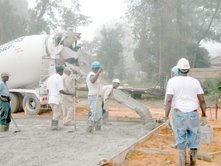
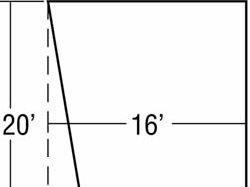
Calculating the amount of concrete needed for slabs (including odd shapes)
Rule of thumb: add 1/4” to the thickness of your slab for your slab concrete budget. This assumes you have the job evenly graded to the right depth, and the grade is well compacted.
If you check your grade and one spot is 4″, some spots are 4.5″ to 5″-the best solution for both the job quality and your concrete budget is to fix the grade.
Odd shapes: Transform odd shapes into rectangles and odd shapes are suddenly easy to figure.
Figure driveway 14′ x 20′ and your estimate will be good. Here is why: The driveway is 16′ at the top and 12′ at the bottom. Through the center the width averages 14′.
Calculating the amount of concrete needed for footings
Footings will rarely follow the drawing exactly. In rocky soil the footings may collapse when big rocks are excavated
This was supposed to be a 12″*12″ footing, but note how the left side of the footing has collapsed. Calculate the true width.
The excavator may have dug too deep, or it may have rained and footings needed to be dug out deeper to reach firm soil. So it is important to check a variety of spots on your footing and get an average size. Then use the calculator to figure the amount of concrete needed.
House slabs on grade that are 8″ out of grade with a 4″ slab also have some of the footing above the grade too.
This 12″ x 12″ footing needs to be calculated 12″ x 16″ so the footing is figured to go above grade to reach the 4″ slab thickness.
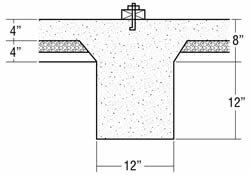
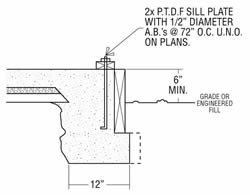
Estimating concrete steps
Steps seem tricky to calculate but are not. If there are three steps leading up to a porch:
- Use the slab calculator to figure the concrete needed for the porch surface.
- Use the footing calculator to calculate the sides of the porch and the steps
Here is an example:
This porch has 9 sq. feet of porch surface, so enter in the slab calculator 4″ thickness by 3′ width by 3′ length. This totals .11 cubic yards.
The porch also has 9 linear feet of 6″ step. So enter in the footing calculator, 6″ depth by 12″ width (always figure steps with a 12″ width) by 9′ length. This totals .17 cubic yards.
The total concrete needed for the 3′ by 3′ porch will be .28 cubic yards. (.11 + .17 cubic yards = .28 cubic yards)
Repeat this for added layers of steps.
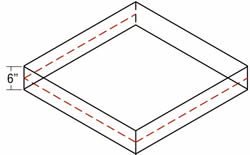
3′ x 3′ Porch
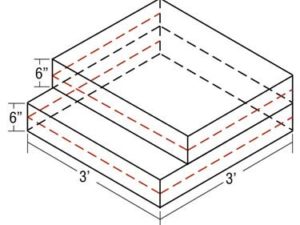
Calculating the amount of base fill
Use this to figure how much material you need for the subgrade.
Using a Margin of Safety: Problems Caused by Underestimating the Amount of Concrete
Never try to order the exact amount of needed concrete. Include a margin of safety.
A perfectly placed order of concrete will finish the job with a small amount left over. A 20 cubic yard order with 1 cubic yard left over is a good order. A 20 cubic yard order that comes up cubic yard short is not a good order.
Extra costs of coming up short of concrete
- Overtime for the crew
- A short load charge from the ready mix supplier
- A cold joint can occur (where one pour ended and another pour began)
Three steps to ordering enough concrete:
- Use the concrete calculator
- Figure depths and widths as they have been built on the site, not simply what the plans say.
- Add a margin of safety
Rule of thumb for margin of safety:
| If your order is | Order this much extra |
| 1-5 cubic yards | .5-1 c.y. extra |
| 6-10 c.y. | 1 c.y. extra |
| 11-20 c.y. | 1-1.5 c.y. extra |
It can be upsetting to end up with any extra concrete. You are having to pay for this concrete after all. However, realize you are doing your job a service by ordering enough concrete – which means you are going to have a little concrete left.
Requesting your ready mix supplier to visit your site
After you have chosen a Ready Mix Supplier, have a representative come to your site to give his/her opinion on the quantity required. Compare the figure with what you came up with. Discuss any variances with the supplier.
Your ready mix supplier is invaluable for checking your view of job conditions, checking your margin of safety, identifying issues you may not have thought of, and informing you of any local conditions you need to be aware of.
